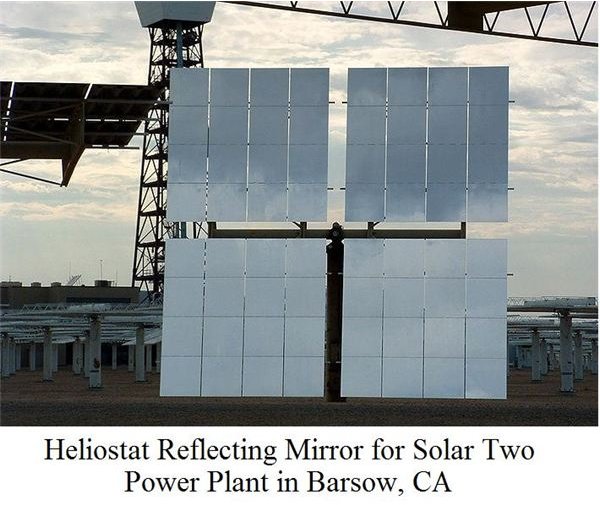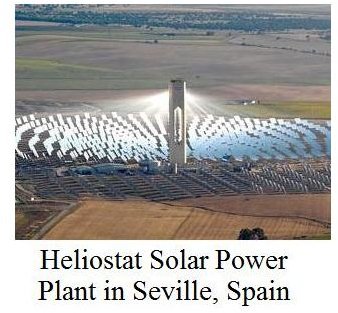The Heliostat Solar Tower Solar Plant Produces Solar Power at a High Efficiency
Introduction
The four technologies in this series (heliostat solar tower, parabolic trough, parabolic dish - stirling engine, and linear fresnel) all focus concentrated solar energy onto a fluid containing receiver of some type, thus heating the fluid to a temperature significantly greater than that obtainable with a simple flat plate solar collector. This higher fluid temperature is needed in order to achieve a reasonable efficiency for conversion of solar power to electricity in a solar plant.
General Configuration of the Heliostat Solar Tower Power Plant
The heliostat solar tower power plant uses a field of two axis, tracking solar mirrors called heliostats. Each heliostat reflects the incoming solar radiation and focuses it on a receiver at the top of a tall tower. The picture at the left shows a heliostat solar power plant that began operation in 2009. This 20 MW solar power plant has 1255 heliostat mirrors, all reflecting to the top of the 160 m tall solar tower. Each heliostat has 120 m2 of surface area.

The picture at the right shows a single heliostat solar mirror from the Solar Two array. Solar One and Solar Two were successive versions of a 10 MW demonstration heliostat solar tower plant that produced solar power near Barstow, CA. Solar One produced solar power using water/steam as the heat transfer fluid from 1982 to 1988. This solar plant was upgraded to Solar Two and operated from 1996 to 1999 heating molten salt to over 1000oF in the receiver at the top of the solar tower. Using hot molten salt as the heat transfer fluid for Rankine cycle generation of solar electricity allowed thermal energy storage, so electricity could be produced continuously.
Advantages and Disadvantages of the Heliostat Solar Tower Power Plant
A few advantages and disadvantages of the heliostat solar tower system in comparison with the other three concentrating solar power technologies under development are summarized here.
Advantages:
- Although the heliostat solar tower approach to solar power production isn’t as commercially developed as the solar parabolic trough system, it is more commercially developed than either the parabolic dish - stirling engine or linear fresnel systems.
- Since the heliostat solar tower system produces steam to generate electricity with a conventional Rankine steam cycle, this system can be hybridized. In other words, it can be designed to use a fossil fuel (typically natural gas) as a supplementary fuel, allowing electricity to be generated when the sun isn’t shining.
Disadvantages:
- The heliostat solar tower system produces a fluid temperature greater than that of the single axis tracking, parabolic trough and linear Fresnel system, but less than that of the two axis tracking, parabolic dish - Stirling engine system. Thus it cannot achieve an efficiency for conversion of electricity from thermal energy as high as that of the parabolic dish - Stirling engine system.
Commercialization Status of the Heliostat Solar Tower Power Plant
The heliostat tower solar plant isn’t as commercially developed as the parabolic trough system, but the 10 MW Solar One and Solar Two demonstration plants have already produced solar power over a 17 year period. The first commercial heliostat solar tower power plant, started operation at 20 MW in April 2009, in Seville, Spain. Several others heliostat/tower solar power plants are in the planning or construction phase worldwide.
Reference and Image Credits
Reference: U.S. Department of Energy, Report to Congress, Concentrating Solar Power Commercial Application Study: Reducing Water Consumption of Concentrating Solar Power Electricity Generation. available at: https://www1.eere.energy.gov/solar/pdfs/csp_water_study.pdf
Image Credits:
Heliostat Solar Power Plant in Seville, Spain - https://www.thestartup.eu/2009/04/abengoas-starts-operating-worlds-largest-solar-tower/
Solar Two Heliostat - https://commons.wikimedia.org/wiki/File:Solar_Two_Heliostat.jpg
About the Author
Dr. Harlan Bengtson is a registered professional engineer with 30 years of university teaching experience in engineering science and civil engineering. He holds a PhD in Chemical Engineering.
This post is part of the series: Concentrating Solar Power Technologies
Concentrating solar technologies bring increased efficiency for solar power conversion to electricity in a solar power plant. The four current concentrating solar technologies are parabolic solar reflectors, heliostat solar power tower, parabolic dish - stirling engine, and linear fresnel systems.
- Concentrating Solar Power Technologies 1: Introduction to Alternatives
- Concentrating Solar Power Technologies 2: Parabolic Dish Stirling Engine Systems
- Concentrating Solar Power Technologies 3: Parabolic Trough Systems
- Concentrating Solar Power Technologies 4: The Heliostat Solar Tower
- Concentrating Solar Power Technologies 5: Linear Solar Fresnel Systems
